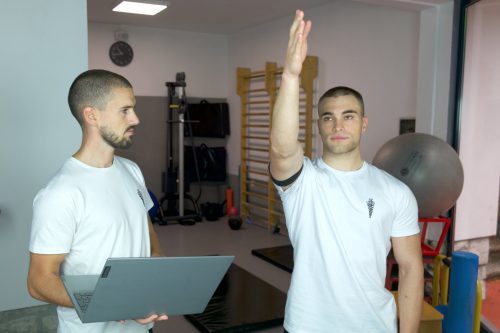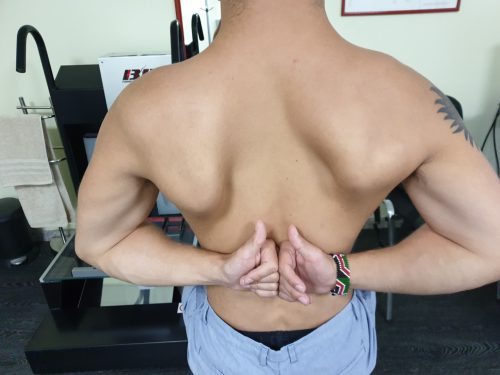This is an unusual condition that only occurs in the shoulder joint and nowhere else in the body. If the patient does not have diabetes, it occurs only once in a lifetime. In over 97% of cases, it leaves no lasting consequences once it passes. Even after 200 years of research, we still do not understand the causes of its onset.
Description
This is an unusual condition that only occurs in the shoulder joint and nowhere else in the body. If the patient does not have diabetes, it occurs only once in a lifetime. In over 97% of cases, it leaves no lasting consequences once it passes. Even after 200 years of research, we still do not understand the causes of its onset.
On the list of bizarre and unexplained phenomena in orthopedic medicine, frozen shoulder is firmly at the top, mainly due to its prevalence. The oddity lies in the fact that we do not understand why the inflammatory process occurs in the joint capsule, let alone the physiology of the “stiffening” of the capsule, characterized by the deposit of additional connective tissue. Even less understood is the gradual “thawing” of the shoulder and its return to full function. It is entirely unclear why only the shoulder “freezes” while no other joint does, suggesting that the shoulder has some specific anatomical and physiological characteristics that we have yet to discover.
These are the reasons why, to this day, we lack a coherent theory of its possible causes. Although many disorders exist whose causes we do not understand, the frequency of frozen shoulder serves as a painful reminder of how far we still have to go in understanding the mechanical and biological specifics of this joint.
It is commonly said that this condition follows three phases. The first is the freezing phase, characterized by significant pain, especially at night, and a gradual loss of movement. This is followed by a relatively calm “frozen” phase, during which the pain is less severe but the movement limitation is at its greatest. Finally, there is a gradual “thawing” phase, marked by the return of movement and function.
In practice, this scenario is relatively rare. It is possible for the first phase with pain to be completely absent. It is also possible for pain to characterize all three phases. It is not uncommon for the pain to be unbearable while the movement restriction is barely noticeable. This variability in manifestations complicates early diagnosis, which is crucial because, if we catch adhesive capsulitis—frozen shoulder’s official name—at the very beginning and respond with cortisone injections, it is possible to stop the process and significantly shorten the duration of the disease. However, in the early stages, the disease has various symptoms, without clear visible movement restriction, making it almost impossible for an untrained eye to recognize the subtle signs typical of it. As a result, we see patients who have been treated for a long time under diagnoses of calcifications, bursitis, or impingement. This prolongs treatment and, more importantly, the patient’s suffering. Therefore, whenever symptoms do not precisely match the given diagnosis, it is essential to suspect frozen shoulder and refer the patient to a shoulder specialist, either an orthopedist or a physiotherapist.
If left untreated and the patient follows the basic advice to avoid painful movements, the condition lasts an average of about a year and a half. When treated with the usual physiotherapy procedures, which include exercising in pain, the average duration extends to two and a half years. In collaboration with colleagues from the Netherlands and the United Kingdom, we have developed and implemented protocols, individually tailored, that allow us to shorten the total treatment process to an average of six months.
There are two clinical forms of adhesive capsulitis. One is a completely frozen shoulder, with full movement limitation. It is easy to diagnose but difficult and time-consuming to treat. The other is a partially frozen shoulder, which is difficult to diagnose but somewhat easier to treat and is characterized by only a partial loss of movement, which can indeed be subtle. I often refer to it as the “great pretender,” named after one of Queen’s more famous songs, because at first glance, it looks like anything but a frozen shoulder.
There is a wealth of available information and “self-help” materials, both written and in video form, that recommend “therapies” and “exercises” for frozen shoulder. As much as I can ask, please do not follow them, as most of them are not based on an understanding of shoulder kinematics, the known part of adhesive capsulitis pathology, and even less are they able to individualize the necessary therapeutic procedures. Only an accurate diagnosis, an individually tailored treatment plan based on the type, scope, and variant of the condition, with due attention to comorbidities (degenerative changes in the cervical and thoracic spine, the condition of the muscular and connective tissue surrounding the shoulder, systemic diseases like diabetes or thyroid problems, and many others), can ensure that you reduce pain and improve your shoulder’s mobility enough for daily life in the shortest possible time, and with a little patience, for desired sports activities as well.
Non-surgical treatment consists of two components. One is cortisone injections, when and if needed, which is in cases of intense pain at rest and during nighttime sleep. They will not contribute to improving mobility but will significantly reduce pain and make physiotherapy easier.
The other is physiotherapy, which in its modern form includes radiofrequency therapy methods (popular TECAR or INDIBA), FMS (high-power magnetotherapy), manual therapy (axial traction of the joint in the painless zone), and a limited set of exercises aimed at stimulating scar tissue to remodel.
Only in the most severe cases, when conservative treatment does not yield satisfactory results in a reasonable time frame, is it possible to proceed with surgical intervention, in which, through an arthroscopic approach, adhesions are “cleaned,” thus freeing the joint. After surgery, appropriate physiotherapy must be conducted for full effect.
Tension Model
It is simple to understand that if the shoulder is blocked, the body will try to make the movement in other ways, such as increased mobility of the scapula, cervical and thoracic spine, and torso. If such compensation lasts long enough, changes will occur in the connective structures that are part of the mentioned body units. These will shorten, further limiting shoulder movement and increasing overall pain intensity. Repairing the detected changes is part of our strategy for accelerated treatment of adhesive capsulitis. For this purpose, trigger point stimulation, fascial manipulation, vertebral manipulation (popular chiropractic), passive stretching, and many other lesser-known techniques can be used.






